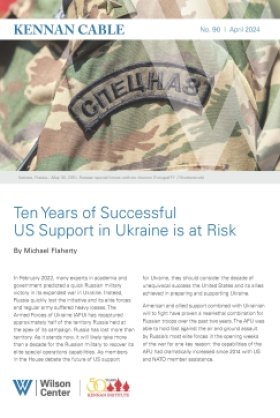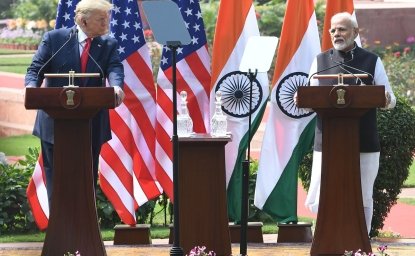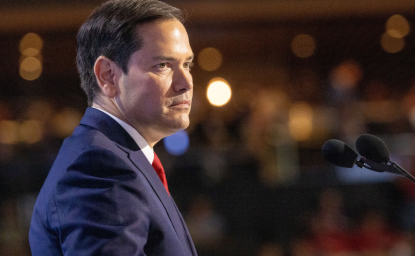Kennan Cable No. 90: Ten Years of Successful US Support in Ukraine is at Risk



In February 2022, many experts in academia and government predicted a quick Russian military victory in its expanded war in Ukraine. Instead, Russia quickly lost the initiative and its elite forces and regular army suffered heavy losses. The Armed Forces of Ukraine (AFU) has recaptured approximately half of the territory Russia held at the apex of its campaign. Russia has lost more than territory. As it stands now, it will likely take more than a decade for the Russian military to recover its elite special operations capabilities. As members in the House debate the future of US support for Ukraine, they should consider the decade of unequivocal success the United States and its allies achieved in preparing and supporting Ukraine.
American and allied support combined with Ukrainian will to fight have proven a near-lethal combination for Russian troops over the past two years. The AFU was able to hold fast against the air and ground assault by Russia’s most elite forces in the opening weeks of the war for one key reason: the capabilities of the AFU had dramatically increased since 2014 with US and NATO member assistance.
Bipartisan Policy Initiative
Few foreign policy initiatives offer as clear a correlation between implementation and outcome as US support to AFU has. There is a clear before and after picture. In 2014, Russia used its special purpose forces to easily capture territory from Ukraine with minimal casualties in Crimea. They also successfully started and sustained separatist conflicts in two more Ukrainian regions in the east. But in 2022, Russia’s “little green men” and regular army were decimated. The improved supply of weapons to the AFU was important, but it pales in comparison with the impact of eight years of training for dedicated Ukrainian troops.
In 2014, the Ukrainian military was not capable of defending its sovereignty. It had a small, corrupt, poorly equipped military, according to its own leadership.[1] Russia’s 2014 land grabs proved to be a critical juncture for both Ukraine and its NATO partners. Volunteers within Ukraine mobilized quickly to hold the line in the east. Longer term, the Obama administration authorized a new policy approach that provided training and equipment to the AFU.
As early as 2015, US Special Operations and Army forces began training Ukrainian counterparts in core military and intelligence competencies. It was a training initiative that “without a doubt, improves the Armed Forces of Ukraine’s capability, readiness, and lethality,” according to a commander of the Joint Multinational Training Group-Ukraine (JMTG-U).[2] Both the Trump and Biden administrations continued providing lethal support to the AFU, bringing it ever closer to NATO standards. Training evolutions in Ukraine only stopped a few weeks prior to the full invasion.
Since February 2022, the United States has provided approximately $47 billion in military aid to the AFU. To be clear, the vast majority of these funds went to US defense contractors and personnel tasked with delivering the equipment.[3] Rather than the newest American gear, Ukraine was provided weapons systems already in our inventory using Presidential Drawdown Authority. Congressionally allocated funds were mainly spent in the United States, to replace those older stocks transferred to Ukraine.
Although the primary beneficiary of this sustained policy was Ukraine, the US military and intelligence services also directly benefitted from this policy. Supporting the JMTG-U provided the U.S. Army National Guard with a stable and consistent mission over those eight years.[4] As mission requirements in Afghanistan and Iraq decreased, the long-term training partnership in Ukraine was critical to US military readiness. Additionally, helping the AFU resist Russian aggression allowed the US Army and other agencies to better understand and counter Russian combat tactics.[5] Every branch of the US military, from the Army to Space Force, has benefitted from observing the efforts of the AFU against a shared adversary.[6] Artillery tactics, anti-drone tactics, and counter electronic warfare are just a few of the areas where this collaboration has improved US competency. With thousands of Russian personnel operating in the open in Ukraine, all Russian tactics are now open for study. It will make countering Russian aggression in Ukraine and further abroad easier for the AFU and its allies.
Highlighting this external support does not minimize the Ukraine’s resolve and sacrifice. Simply giving a partner force the tools to improve its effectiveness is a necessary but not sufficient step in achieving our policy objectives. In fact, having a dedicated partner with high resolve is often the most important factor to mission (or policy) success. Missions where this is lacking are often counterproductive in the long term. Success comes from the interaction between good policy and strong partner force will. This bears repeating, given the policy environment in the United States and Europe currently. Effective US and European policy paired with Ukrainian resolve resulted huge military losses for a declared U.S. adversary.[7]
After a summer of difficult fighting in 2023, Ukraine was on the verge of making significant advances in October, especially in the south. The AFU broke through layers of Russian entrenched defenses in multiple locations.[8] Russia was staring a catastrophic military defeat in the face—until Ukraine’s ammunition supply began to run dry.[9]
The loss of predictability in material support has put the Ukrainian military at risk and prevented any attempted advance. The timing of the disruption was no accident. As the AFU was establishing military positions on the east side of the Dnipro in the autumn of 2023, Russian influence operations in the U.S. and Europe intensified. Russian propaganda about corruption and stalemates began dominating policy debates.[10] The result: additional funding for Ukraine was put on hold in both Washington and Brussels.
This creates an unusual situation. After ten years of success helping the AFU develop into a force that can credibly defend itself against a “great power,” continued support is now at risk. Ukrainian officials, from President Zelenskyy down, are understandably concerned. Their state is facing an existential threat. Subduing Ukraine was not the only goal of the Russian “special military operation.” It was only phase one. Russia had standing plans to target another prospective EU state, Moldova, once Ukraine had been subdued. Therefore, it is important and timely to consider how, specifically, NATO member support to the AFU has degraded the Russian adversary and perhaps prevented additional conflict.
Battlespace Impact
Western media and policymakers may not fully comprehend the severity of the losses Russia has sustained. Consider Russia’s elite or special purpose military forces: Naval Infantry (MP), Air Assault (VDV), and Army and Navy Spetsnaz brigades.[11] Doctrinally, these are the only forces that matter for Russia. With a regular army largely made up of conscripts, Russian doctrine relies on mass to overwhelm an enemy after special purpose forces have led a vanguard incursion to soften the target. Long term efforts to modernize Russia’s military have only placed greater reliance on this strategy. Without battle-ready special purpose forces, Russia’s ability to wage offensive war is greatly curtailed, as is Russia’s ability to project military power.
A snapshot of the Russian performance in the war thus far provides a clear picture of strategic failure. Official US estimates from December 2023 show that Russian conventional forces have suffered catastrophic losses. They have likely suffered more than 300,000 casualties to all ground forces. This means that about 90% of Russia’s pre-war army has been killed or wounded in action. For Russian leaders, losing thousands of regular army conscripts is inconsequential. The results in Bakhmut and Avdiivka reinforce Russia’s willingness to use human waves as their primary tactic. However, several elite brigades also suffered 90% combat losses and may not be recoverable.[12]
Prior to 2022, Russian Army and Navy Spetsnaz brigades were considered near-peer to US special forces. Analysts in the United States also thought highly of the even more elite Spetsnaz units in the Russian Joint Special Operations Command (KSSO). The VDV and MP were considered less capable, but still formidable. Special operations forces in the United States and NATO were tasked with countering these Russian formations. Both Spetsnaz and VDV had some operational successes in Chechnya, Crimea, Donbas, Kazakhstan, Georgia, and Syria over the past 20 years, helping build Russian prestige. Yet all these missions were conducted against unprepared and far inferior adversaries. They found a far different opponent in the AFU in 2022. Ukraine, with Western assistance, had been preparing since 2014 for the next Russian assault.
In early 2023, U.S. geospatial intelligence analysis concluded that four out of five Army Spetsnaz brigades that saw combat in Ukraine in 2022 returned to Russia in a non-mission capable (NMC) state.[13] A few examples of Spetsnaz losses may be helpful to put this in context. The elite 346th Spetsnaz Brigade from the KSSO returned to garrison in 2022 with only 125 of 900 personnel. It functionally ceased to exist. The 22nd Separate Guards Brigade and two others had an even higher attrition rate, with between 90 to 95% lost as casualties. There was no clear signature that these units even returned to garrison.[14]
Both the VDV and MP brigades experienced similar losses. For example, the 331st Guards Parachute regiment was destroyed during fighting in Ukraine. After combat in 2022, the VDV has likely been reduced to 50% of its pre-war capacity. For the MP, there were similar results. It lost two of four brigades in Ukraine, meaning two Russian fleets no longer have a marine component for security. Instead of decapitating Ukrainian leadership, Russia has lost more than half of its elite forces.
All losses on the battlefield are costly. Some are more costly, however, considering the training time and resources required to reconstitute a troop. For VDV and MP a conservative peacetime timeline to reconstitute a unit is between three and five years. To replace the Spetsnaz losses, it likely takes between six to ten years from entry into the armed forces to reconstitute a fully trained, fully mission capable (FMC) special purpose operator. For Spetsnaz personnel screened for KSSO, a further two years of training is normally necessary. But these are peacetime estimates and assumes all candidates screened for spetsnaz are second- or third-term contract personnel.
Of course, neither the Ukrainian nor Russian forces are at peace, so reconstitution timelines become fuzzy. The case of the 155th MP provides a good illustration. This unit was rendered NMC in 2022 but reconstituted twice and sent back into Ukraine.[15] Replacement personnel probably had no specialized training, and the unit was repeatedly fielded as an inferior force. Further, if the 155th MP ceases to exist, the pool of potential new recruits for Naval Spetsnaz is reduced, hindering the ability of these more capable units to reconstitute personnel. Likewise, if the 22nd Separate Guards Brigade is functionally broken, there are no personnel to select or train Spetsnaz replacements.
In short, all elite Russian forces are connected in a training and development cycle. Losses in Ukraine have broken this cycle, so reconstitution will take significantly longer than the process during peacetime. How much longer will depend on how long the war lasts. Currently, there is no path to returning to a peacetime scenario, so the Russian General Staff will likely try to reconstitute these forces on a much quicker timeline. This will put new recruits to elite units at higher risk and will limit training opportunities. It is very likely Russian elite units will not recover pre-war capabilities for six to 12 years after the war ends. Some brigades may not recover at all.
The Russian military has lost most of its ground offensive capability for at least the next decade. While conscripts can backfill conscripts, the Spetsnaz and other elite forces cannot be replaced quickly. The quality of Russian troops will continue to decline as long as the war in Ukraine continues.
Strategic Impact
From a strategic standpoint, training and equipping the AFU is probably the most successful US foreign policy initiative since World War II. Eight years of training and two years of weapons shipments have done what almost 50 years of Cold War military spending could not do: decimate the Russian military. Imagine what National Security Advisor Kissinger or Scowcroft would think about the value of spending about $50 billion to achieve such results. They would probably argue its results were worth ten times that amount—and they would certainly be in favor of continuing to build on that success with additional resources.
If the policy of training and equipping the AFU is restored and maintained, Russia will lose the war in Ukraine. Even if Russia manages to retain some internationally recognized Ukrainian territory in a future armistice, it has already lost the war by several measures:
The losses inflicted by the AFU will limit Russia’s offensive capability for the next 10 to 20 years. The joint Ukraine and NATO effort may have also insulated Belarus, Moldova, and Georgia from additional territory grabs by Russia. As Robert Litwak has argued, war in Ukraine has likely reduced Russia to being a one-dimensional nuclear power.[18] This is a positive, but only preliminary, outcome.
Based on the outcomes of the war thus far, it is imperative for the United States to commit the additional $60 billion to help Ukraine functionally destroy the Russian Army and eject the Black Sea Fleet from the Black Sea. The Putin regime has engaged in gray zone warfare against the United States for more than a decade. Allowing the same government time to reconstitute its military and retake territory from a Ukrainian ally is unconscionable from a national security policy standpoint. Further, a loss in Ukraine could force the Putin regime out of power. Historically, authoritarian regimes that lose external conflicts or achieve minimal gain are at risk of internal collapse.[19]
In October 2023, Russia’s defensive lines in Ukraine began to buckle. With uninterrupted US weapons shipments, the AFU may have been able to reinforce the breech and expand it. Instead, Russian propaganda has helped delay critical congressional support for almost six months. Ukraine has time-sensitive military needs. Delays cost lives and will soon cost Ukraine more of its sovereign territory. As Russia continues to receive timely resupply from North Korea and Iran, the United States looks increasingly wobbly as an ally. Leaders in the People's Republic of China have likely taken note.
[1] Valeriy Akimenko, “Ukraine’s Toughest Fight: The Challenge of Military Reform,” Carnegie Endowment for International Peace, February 22, 2018, https://carnegieendowment.org/2018/02/22/ukraine-s-toughest-fight-challenge-of-military-reform-pub-75609.
[2] Matthew Baldwin, “Task Force Raven Takes Command of Joint Multinational Training Group-Ukraine,” U.S. Army, April 17, 2021, https://www.army.mil/article/245354/task_force_raven_takes_command_of_joint_multinational_training_group_ukraine.
[3] Elizabeth Hoffman, Jaehyun Han, and Shivani Vakharia, “The Past, Present, and Future of U.S. Assistance to Ukraine: A Deep Dive into the Data,” Center for Strategic & International Studies, September 26, 2023, https://www.csis.org/analysis/past-present-and-future-us-assistance-ukraine-deep-dive-data.
[4] Jared Saathoff, “Red Arrow Soldiers Deployed in Ukraine for Multinational Mission,” Defense Visual Information Distribution Service, 2019, https://www.dvidshub.net/news/353722/red-arrow-soldiers-deployed-ukraine-multinational-mission; and Gleb Garanich, “Ukraine Holds Military Drills with US, Poland, Lithuania,” Reuters, 2021.
[5] Wesley Morgan, “US Army Unprepared to Deal with Russia in Europe,” Politico, 2017, https://www.politico.eu/article/us-army-unprepared-to-deal-with-russia-in-europe/.
[6] Caleigh Kelly, “Russia-Ukraine War Holds Key Lessons for US Space Command: Top Official,” The Hill, 2023, https://thehill.com/policy/defense/4089559-russia-ukraine-war-holds-key-lessons-for-us-space-command-top-official/; and Jen Judson, “Change of Plans: US Army Embraces Lessons Learned from War in Ukraine,” Defense News, 2023, https://www.defensenews.com/land/2023/10/09/change-of-plans-us-army-embraces-lessons-learned-from-war-in-ukraine/.
[7] Russia has engaged in political and cyber warfare against NATO member states in both the near abroad and further.
[8] Mstyslav Chernov and Lori Hinnant, “How Ukrainian Special Forces Secured a Critical Dnipro River Crossing,” Associated Press, 2023, https://www.voanews.com/a/how-ukrainian-special-forces-secured-a-critical-dnipro-river-crossing/7413472.html.
[9] In addition to Russian ground force losses, the AFU has also significantly degraded the Russian air component and forced the Black Sea Fleet to flee Crimea.
[10] Katie Bo Lillis, “Newly Declassified US Intel Claims Russia Is Laundering Propaganda through Unwitting Westerners,” CNN, 2023, https://www.cnn.com/2023/08/25/politics/us-intel-russia-propaganda/index.html; and Hoffman, Han, and Vakharia.
[11] See Galeotti (2022) for a reasonable description of each of the elite forces and their mission and training profiles.
[12] Alex Horton, “Russia’s Commando Units Gutted by Ukraine War, U.S. Leak Shows,” Washington Post, 2023; and Warren P. Strobel and Matthew Luxmoore, “Russia Has Lost Almost 90% of Its Prewar Army, U.S. Intelligence Says; The Declassified Estimate Says 315,000 Personnel Have Been Killed or Injured in Ukraine,” Wall Street Journal, December 12, 2023, https://www.wsj.com/articles/russian-has-lost-almost-90-of-its-prewar-army-u-s-intelligence-says-2e0372ab.
[13] If a unit falls below 50% combat readiness, it is considered non-mission capable.
[14] Alex Horton, “Russia’s Commando Units Gutted by Ukraine War, U.S. Leak Shows,” Washington Post, 2023.
[15] Ellie Cook, “Russia’s ‘Elite’ Units Might Not Be So Elite,” Newsweek, 2023; and Ellie Cook, “Russian General’s Leak of Elite Casualties ‘Endorses’ 50% Loss Figure: U.K.,” Newsweek, 2023.
[16] International Institute for Strategic Studies, The Military Balance 2024 (London, UK: Routledge, 2024), https://doi.org/10.4324/9781003485834.
[17] Russia had among the lowest birth rates in the world prior to 2022 and a high death rate among military aged males, according to the CDC International Database. See United States Census Bureau, “International Database: World Population Estimates and Projections,” https://www.census.gov/programs-surveys/international-programs/about/idb.html; and Jennifer Dabbs Sciubba, The Future Faces of War: Population and National Security (Santa Barbara, CA: Praeger, 2011): 40, 134-137.
[18] Robert S. Litwak, Tripolar Instability: Nuclear Competition Among the United States, Russia, and China (Washington, DC: Wilson Center, 2023).
[19] Alyssa K. Prorok, “Leader Incentives and Civil War Outcomes,” American Journal of Political Science 60, no. 1 (2016): 70; and Mark Peceny and Christopher K. Butler, “The Conflict Behavior of Authoritarian Regimes,” International Politics 41 (2004): 565–81.


The Kennan Institute is the premier US center for advanced research on Eurasia and the oldest and largest regional program at the Woodrow Wilson International Center for Scholars. The Kennan Institute is committed to improving American understanding of Russia, Ukraine, Central Asia, the South Caucasus, and the surrounding region though research and exchange. Read more


